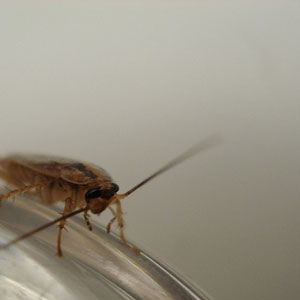A Crack & Crevice Tip Improves Cockroach Control
By Chris Williams on October 29, 2013.

Question
I was looking at cockroach sprays in the drug store the other day. Why do a lot of the spray cans have skinny plastic straws attached? It seems like the spray would be more effective if you spray a wide area with the nozzle instead of using that tiny straw.
Answer
It’s actually just the opposite. You’re talking about a crack and crevice injector tip and that’s a much better way to spray for cockroaches or apply gel bait. Some of us have been in the pest control business long enough to remember back when we always controlled cockroaches by using a fan spray, a wide swath along baseboards or kitchen surfaces. We didn’t really know any better. Now we do. Now we know that the best way to control cockroaches is to get the insecticide into places where the cockroaches are hiding—and that means cracks and crevices. On their large professional sprayers, our technicians often use a narrow, tubular crack and crevice tip that they can stick directly into cracks and tight areas.
You don’t see cockroaches living out in the open, they prefer dark cracks and crevices or tight spaces. They like being crowded together and like the feel of having both their front and their back pressed against a surface. Our common German cockroach prefers to live inside a crack only 3/16 inch wide; nymphs like a space that is even smaller. If you can slip a business card into a crack, it’s the right size for a cockroach. As long as their hiding places remain undisturbed, cockroaches stay clustered together and protected, traveling out only for food and water, usually at night.
Where to Apply a Crack and Crevice Treatment
When you use a crack and crevice tip, make sure you put the tip of the tip into the crack. Don’t fire at the opening from a distance. Typical cracks and crevices where cockroaches hide are the narrow space where kitchen cabinets abut each other, the space between the back of the cabinets and the wall, the space between the wall and the countertop backsplash, space around pipes where they enter the wall, the space between the cabinet door and the frame when closed, and the space between the pantry door and the door frame. There are other cracks and crevices inside kitchen appliances, in hollow table legs, and in drawer slides. Insecticides are also injected into wall voids and other small spaces using crack and crevice tips. You can see why a crack and crevice treatment can take a lot of time. The cracks and crevices just in a typical kitchen are too numerous to mention. Pest control pros, though, know where to find all those crack and crevice cockroach hiding places.
There are many other reasons why using that injector tip is a good idea:
- Crack and crevice application keeps the insecticide away from you, your children, and your pets.
- Crack and crevice application reduces the risk of food and surface contamination from insecticides.
- Crack and crevice application reduces odor and irritation from insecticides.
- Crack and crevice application protects the insecticide from breakdown by sunlight and water, giving longer lasting control.
- From our perspective, a crack and crevice application wastes less insecticide by putting it precisely where it needs to be for effective cockroach control.
photo credit: Sarah Camp via photopin cc